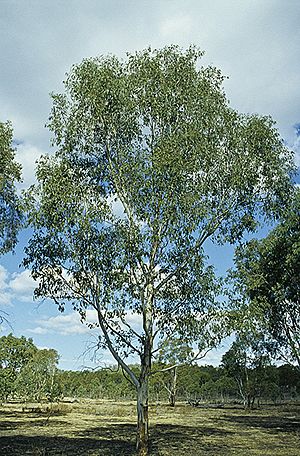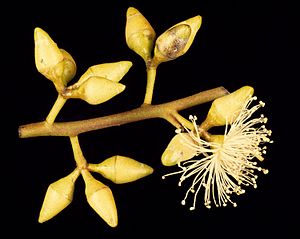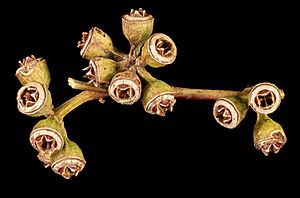Baradine gum facts for kids
Quick facts for kids Baradine gum |
|
|---|---|
 |
|
| Eucalyptus chloroclada on Carnarvon Station Reserve | |
| Scientific classification | |
| Genus: |
Eucalyptus
|
| Species: |
chloroclada
|
The Baradine gum (also called red gum or dirty gum) is a type of tree found only in eastern Australia. It's a small to medium-sized tree. This tree often has rough, flaky bark on its main trunk, but smooth bark higher up. Its leaves are shaped like a spear, and its flowers are white, growing in groups of seven. The fruit looks like a small, round cap.
What Does Baradine Gum Look Like?
The Baradine gum tree usually grows up to 20 m (66 ft) tall. It has a special woody swelling at its base called a lignotuber. This helps the tree regrow if it's damaged by fire.
The bark on the main trunk is rough and can be flaky or fibrous. Higher up on the branches, the bark is smooth and can be white or cream-colored. Some trees in Queensland might not have rough bark at all.
Young Baradine gum plants and new shoots (called coppice regrowth) have leaves that are grey-green and often egg-shaped. These leaves are about 60–150 mm (2.4–5.9 in) long and 40–75 mm (1.6–3.0 in) wide.
Adult leaves are shiny and green to grey-green on both sides. They are shaped like a spear, measuring 85–180 mm (3.3–7.1 in) long and 10–35 mm (0.39–1.38 in) wide. Each leaf has a stem (called a petiole) about 15–25 mm (0.59–0.98 in) long.
The tree's flower buds usually grow in groups of seven. These groups are on a small stalk (a peduncle) about 5–12 mm (0.20–0.47 in) long. Each individual bud has an even smaller stalk (a pedicel) about 1–4 mm (0.039–0.157 in) long.
When the buds are ready, they are oval or diamond-shaped, about 7–12 mm (0.28–0.47 in) long and 3–6 mm (0.12–0.24 in) wide. They have a cone-shaped cap (an operculum) that is 5–9 mm (0.20–0.35 in) long.
Baradine gum trees flower between August and December, and their flowers are white. The fruit is a woody, half-sphere-shaped capsule, about 2–5 mm (0.079–0.197 in) long and 4–7 mm (0.16–0.28 in) wide. The parts that open to release seeds stick out above the rim.
How Did It Get Its Name?
The Baradine gum was first described in 1934 by a botanist named William Blakely. He gave it a longer scientific name at first.
Later, in 1988, two other botanists, Lawrie Johnson and Ken Hill, changed its name to Eucalyptus chloroclada. This updated name was published in a big book series called Flora of Australia.
The second part of its scientific name, chloroclada, comes from two Ancient Greek words:
- chloros means "green"
- klados means "branch" or "stem"
So, chloroclada basically means "green-branched".
Where Does Baradine Gum Grow?
Eucalyptus chloroclada mostly grows on sandy plains and hills. It is often found in woodlands, usually alongside Callitris trees (which are a type of cypress pine).
You can find this tree on the western slopes and plains of New South Wales in Australia. It grows mainly from the Pilliga forest and Gilgandra, stretching north to Dirranbandi in south-east Queensland.



